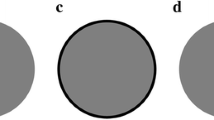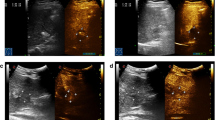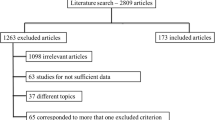Abstract
Objective
Irreversible electroporation (IRE) is a new ablation modality. Our purpose was to describe the effectiveness and the safety of the treatment and to evaluate the magnetic resonance imaging (MRI), computed tomography (CT) and contrast-enhanced ultrasound (CEUS) diagnostic accuracy in HCC patients treated with IRE at 1-, 3-, and 6-month follow-up.
Materials and methods
In an 18-month period, we treated 24 HCC lesions in 20 patients unfit for surgery. MRI, CT and CEUS were performed before and one, 3 and 6 month after IRE. We employed the liver-specific contrast medium Primovist (gadolinium ethoxybenzyl dimeglumine) in MRI. After IRE the lesions were classified as responders or non-responders to the treatment according to the mRECIST and the complications were recorded. We evaluated the size, shape, signal intensity (T1-W, T2-W, and DWI) in MRI, dynamic contrast enhancement pattern for CEUS, CT and MRI and signal behavior during the liver-specific phase for MRI.
Results
According to mRECIST, at 1 month MRI and CEUS showed a complete response (CR) in 91.7 % of cases (22/24) tumors, while there was partial response (PR) in the remaining 2/24 (8.3 %) treated nodules; in CT study all ablated zone appeared as necrotic (CR 100 %). The residual viable tumor in MRI and in CEUS study had similar diameter (10 mm). No new HCC were identified from MRI, CT or CEUS. At 3 months MRI and CEUS showed the same results seen after 1 month from the treatment. Twenty-two necrotic lesions, and 2 residual tumors were found (CR = 91.7 % and PD = 8.3 %). In MRI study the two cases of residual tumor tissue had a diameter of 11 and 12 mm each. At CEUS the diameter of residual HCC was similar to the diameter at 1 month. CT showed 23 necrotic areas and one residual viable tissue in the treated zone, with a diameter of 10 mm (CR = 95.3 % and PD = 4.7 %). No new foci of HCC were identified from all imaging studies. At 6 months MRI, CEUS, and CT showed 22 necrotic lesions and 2 residual tumors in ablated zone (CR = 91.7 % and PD = 8.3 %). At MRI the diameters of the two residual viable HCCs were 12 and 14 mm, at CEUS the diameters were 11 and 12 mm, while at CT the diameters were 10 and 10 mm. No statistical difference was evaluated between CR, PR, PD percentage values for MRI, CT and CEUS (p value > 0.05 at Chi-square test). No major vascular complication was recorded after IRE. Six out of 20 patients (30 %) showed a transient hepatic intensity difference (THID) area within the normal liver parenchyma adjacent to the treated lesions. Two of the 20 patients (10 %) showed an absent concentration of liver-specific contrast medium around the ablation zone. Two patients developed complications, consisting in a peripheral arteriovenous shunt and a segmental dilation of the intrahepatic biliary ducts. We found no statistically significant difference in morphology, size (variation in the largest diameter), signal intensity in T1-weighted images, in T2-weighted images, in DWI and in the related map of the apparent diffusion coefficient (ADC), presence or absence of contrast enhanced during the arterial, portal, and late phase in MRI, CT, and CEUS, and signal characteristic during the liver-specific phase in MRI of the ablation zone at 1, 3, and 6 months.
Conclusion
IRE is a feasible, safe and efficient modality in the treatment of patients with non-resectable HCC. We had no major complication, even when the ablated lesion was adjacent to major branches of the portal vein. All images techniques showed similar accuracy during the follow-up at 1, 3, and 6 months in the assessment ablated zone.




Similar content being viewed by others
References
Bruix J, Sherman M, American Association for the Study of Liver Diseases (2011) Management of hepatocellular carcinoma: an update. Hepatology 53:1020–1022
European Association for the Study of the Liver*, European Organisation for Research and Treatment of Cancer (2012) EASL-EORTC Clinical Practice Guidelines: management of hepatocellular carcinoma. Eur J Cancer 48:599–641
Curley SA, Izzo F, Ellis LM et al (2000) Radiofrequency ablation of hepatocellular cancer in 110 patients with cirrhosis. Ann Surg 232:381–391
Curley SA, Marra P, Beaty K et al (2004) Early and late complications after radiofrequency ablation of malignant liver tumors in 608 patients. Ann Surg 239:450–458
Thomson KR, Cheung W, Ellis SJ et al (2011) Investigation of the safety of irreversible electroporation in humans. J Vasc Interv Radiol 22:611–621
Philips P, Hays D, Martin RC (2013) Irreversible electroporation ablation (IRE) of unresectable soft tissue tumors: learning curve evaluation in the first 150 patients treated. PLoS ONE 8:e76260
Deodhar A, Dickfeld T, Single GW et al (2011) Irreversible electroporation near the heart: ventricular arrhythmias can be prevented with ECG synchronization. AJR 196:W330–W335
Appelbaum L, Ben-David E, Faroja M et al (2014) Irreversible electroporation ablation: creation of large-volume ablation zones in in vivo porcine liver with four-electrode arrays. Radiology 270:416–424
Miller AB, Hoogstraten B, Staquet M et al (1981) Reporting results of cancer treatment. Cancer 47:207–214
Eisenhauer EA, Therasse P, Bogaerts J et al (2009) New response evaluation criteria in solid tumours: revised RECIST guideline (version 1.1). Eur J Cancer 45:228–247
Lencioni R, Llovet JM (2010) Modified RECIST (mRECIST) assessment for hepatocellular carcinoma. Semin Liver Dis 30:52–60
Yang W, Yan K, Wu GX et al (2015) Radiofrequency ablation of hepatocellular carcinoma in difficult locations: strategies and long-term outcomes. World J Gastroenterol 21:1554–1566
Granata V, Petrillo M, Fusco R et al (2013) Surveillance of HCC patients after liver RFA: role of MRI with hepatospecific contrast versus three-phase CT scan. Experience of high volume oncologic institute. Gastroenterol Res Pract 2013:469097
Goldberg SN, Grassi CJ, Cardella JF et al (2005) Image-guided tumor ablation: standardization of terminology and reporting criteria. J Vasc Interv Radiol 16:765–778
Appelbaum L, Ben-David E, Faroja M et al (2014) Irreversible electroporation ablation: creation of large-volume ablation zones in in vivo porcine liver with four-electrode arrays. Radiology 270:416–424
Ben-David E, Ahmed M, Faroja M et al (2013) Irreversible electroporation: treatment effect is susceptible to local environment and tissue properties. Radiology 269:738–747
Deodhar A, Monette S, Single GW Jr et al (2011) Percutaneous irreversible electroporation lung ablation: preliminary results in a porcine model. Cardiovasc Intervent Radiol 34:1278–1287
Lee YJ, Lu DS, Osuagwu F et al (2013) Irreversible electroporation in porcine liver: acute computed tomography appearance of ablation zone with histopathologic correlation. J Comput Assist Tomogr 37:154–158
Guo Y, Zhang Y, Klein R et al (2010) Irreversible electroporation therapy in the liver: longitudinal efficacy studies in a rat model of hepatocellular carcinoma. Cancer Res 70:1555–1563
Zhang Y, Guo Y, Ragin AB (2010) MR imaging to assess immediate response to irreversible electroporation for targeted ablation of liver tissues: preclinical feasibility studies in a rodent model. Radiology 256:424–432
Lencioni R, Izzo F, Crocetti L et al (2012) A prospective, multicenter phase II clinical trial using irreversible electroporation for the treatment of early stage HCC. J Vasc Interv Radiol 23:1114
Sugimoto K, Moriyasu F, Kobayashi Y et al (2015) Irreversible electroporation for nonthermal tumor ablation in patients with hepatocellular carcinoma: initial clinical experience in Japan. Jpn J Radiol [Epub ahead of print]. doi:10.1007/s11604-015-0442-1
Cheung W, Kavnoudias H, Roberts S et al (2013) Irreversible electroporation for unresectable hepatocellular carcinoma: initial experience and review of safety and outcomes. Technol Cancer Res Treat 12:233–241
Lee EW, Wong D, Prikhodko SV et al (2012) Electron microscopic demonstration and evaluation of irreversible electroporation-induced nanopores on hepatocyte membranes. J Vasc Interv Radiol 23:107–113
Lencioni R, Crocetti L (2012) Local-regional treatment of hepatocellular carcinoma. Radiology 262:43–58
Bower M, Sherwood L, Li Y et al (2011) Irreversible electroporation of the pancreas: definitive local therapy without systemic effects. J Surg Oncol 104:22–28
Silk MT, Wimmer T, Lee KS et al (2014) Percutaneous ablation of peribiliary tumors with irreversible electroporation. J Vasc Interv Radiol 25:112–118
Granata V, Fusco R, Catalano O et al (2015) MRI findings after irreversible electroporation of hepatocellular carcinoma. AJR 204:1000–1007
Eisele RM, Schumacher G, Lopez-Hänninen E et al (2007) Role of B-mode ultrasound screening in detection of local tumor recurrence in the first year after radiofrequency ablation in the liver. Cancer Detect Prev 31:316–322
Khankan AA, Murakami T, Onishi H et al (2008) Hepatocellular carcinoma treated with radiofrequency ablation: an early evaluation with magnetic resonance imaging. J Magn Reson Imaging 27:546–551
Paudyal B, Oriuchi N, Paudyal P et al (2007) Early diagnosis of recurrent hepatocellular carcinoma with 18F-FDG PET after radiofrequency ablation therapy. Oncol Rep 18:1469–1473
Ayuso C, Rimola J, García-Criado A (2012) Imaging of HCC. Abdom Imaging 37:215–230
Catalano O, Izzo F, Vallone P et al (2015) Integrating contrast-enhanced sonography in the follow-up algorithm of hepatocellular carcinoma treated with radiofrequency ablation: single cancer center experience. Acta Radiol 56:133–142
Acknowledgments
The authors are grateful to Alessandra Trocino, librarian at the National Cancer Institute of Naples, Italy.
Author information
Authors and Affiliations
Corresponding author
Ethics declarations
Conflict of interest
The authors have no conflict of interest to be disclosed.
Ethical statement
All procedures performed in studies involving human participants were in accordance with the ethical standards of the institutional and/or national research committee and with the 1964 Helsinki declaration and its later amendments or comparable ethical standards. Informed consent was obtained from all individual participants included in the study.
Rights and permissions
About this article
Cite this article
Granata, V., de Lutio di Castelguidone, E., Fusco, R. et al. Irreversible electroporation of hepatocellular carcinoma: preliminary report on the diagnostic accuracy of magnetic resonance, computer tomography, and contrast-enhanced ultrasound in evaluation of the ablated area. Radiol med 121, 122–131 (2016). https://doi.org/10.1007/s11547-015-0582-5
Received:
Accepted:
Published:
Issue Date:
DOI: https://doi.org/10.1007/s11547-015-0582-5




